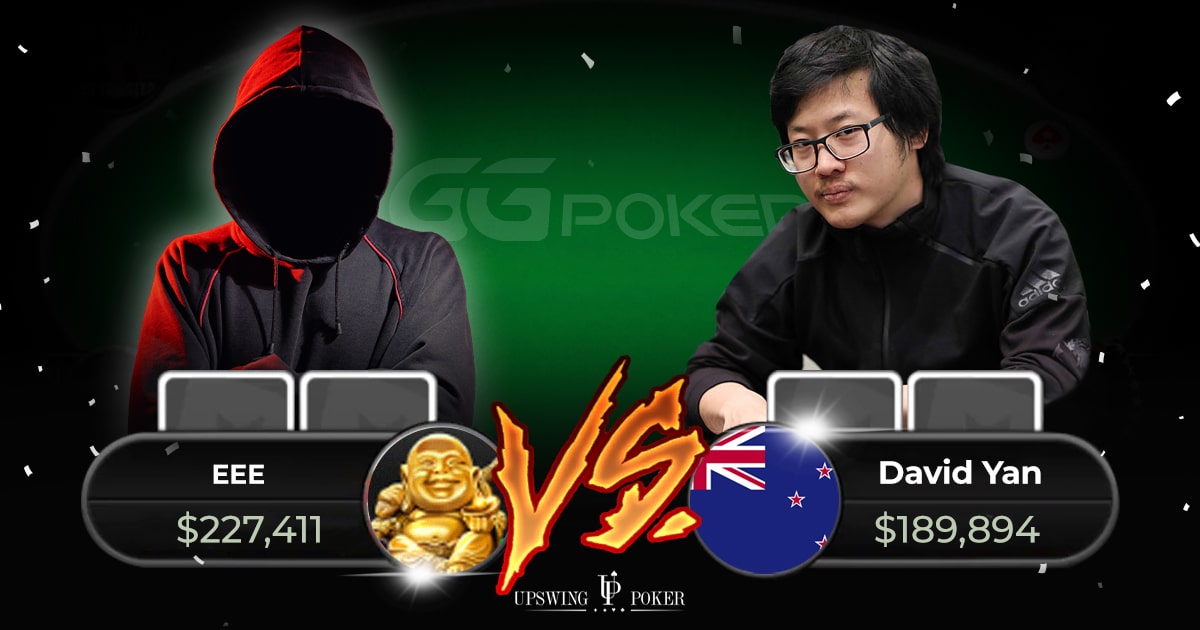Upswing Coach Plays Unbelievable $379,789 Pot (Analysis)

Upswing Lab coach David “MissOracle” Yan has been playing in some massive games this year.
He had a big score at a recent Triton high roller series, winning a $200,000 buy-in tournament for $3,052,002.

He has carried this success into the online cash arena, battling in some of the biggest online pots of the year.
In this article, I am going to show you a $200/$400/$800 with a $200 ante pot that he played on GGPoker vs unknown player EEE.
Let’s get into it!
Preflop Action
David starts the hand with a $189,894 stack and his opponent covers.
David open-raises to $1,800 from the Cutoff with . EEE calls from the Small Blind with . The Straddle calls as well with an unknown hand.
Preflop Analysis
This three blind plus ante structure entices the players to adopt a very loose preflop strategy. The extra money in the pot improves everyone’s pot odds, enticing the players to throw a lot of money into the pot.
Given all the dead money, David should be open-raising with the top 35-40% of hands from the Cutoff. In a “normal” game with just two blinds and no antes, the optimal Cutoff raising range is more like 25-30% of hands. That’s quite a big difference!
Pocket Jacks are a no-brainer open-raise in any format. His sizing is good too. Anything between $1,600 and $2,400 (3x to 4x the straddle) would work fine, giving the rest of the players a more difficult time defending their blinds.
Given this open-raise size, the Small Blind should do a lot of calling and some 3-betting. It’s hard to say exactly how wide he should defend here given that there are 2 players left to act in position, but calling and 3-betting with around the top 20-25% of hands seems like a good strategy.
EEE’s defense from the Small Blind with is likely good given the pot odds that he’s being laid. In a 2 blind game, this would be too loose of a call from the Small Blind.
The Straddle should defend with an enormous amount of hands given that he is closing the action and has by far the best pot odds of all the players. The details of this range, however, won’t be relevant in this hand since he will be folding on the next street.
Flop Action
The flop comes . The pot is $7,000.
EEE checks with . The Straddle checks.
David bets $1,750 with .
EEE check-raises to $7,000. Straddle folds.
David 3-bets to $15,800.
EEE- 4-bets to $41,200. David calls.
Flop Analysis
What an unbelievable street!
Both EEE and the player in the Straddle should be checking their entire range as they will be at a large disadvantage in this type of scenario (wide range, out-of-position, multiway, and a high stack-to-pot ratio).
David should be firing a small c-bet at a high frequency on this type of flop and his top set with Jacks fits into this. He is in position vs two players that will often miss this flop.
EEE’s decision to check-raise here is very ambitious. He should definitely check-raise sometimes in this situation, just not with this hand.
For value, EEE should check-raise the bottom two flopped sets. But when choosing bluffs, King-Ten offsuit doesn’t make any sense. He only has 2 backdoor straight draws and one overcard. There are much better hands to choose from such as:
Back to David now who, in theory, shouldn’t 3-bet with any hands (even top set). But the theoretical correct strategy assumes the opponent is check-raising with a perfectly balanced and polarized range.
If David thinks his opponent is going to play back against a 3-bet too aggressively or too passively, then he becomes incentivized to 3-bet.
What David was probably thinking was this: We are playing very deep (north of 200 straddles each), I has the nuts, and my opponent is likely a weaker player. It would probably be higher expected value (EV) for him to build the pot as soon as possible in order to stack Pocket Threes and Pocket Twos.
If he doesn’t start 3-betting on the flop, then it becomes significantly harder to stack those hands as there are many runouts that can kill EEE’s enthusiasm to stack off (such as straight completing cards or even overcards where David can credibly represent stronger sets).
EEE’s 4-bet is simply ludicrous. He has a paltry <5% equity against the range that would continue against his 4-bet. Furthermore, it is extremely likely that David is 3-betting with an unbalanced range towards value hands. The 4-bet is a big punt at this point.
David decides that slow-playing against the 4-bet is best since he’ll easily be able to get stacks in by the river with the pot already this bloated. I agree.
Turn Action
The turn comes the , making the board . The pot is $89,400.
EEE bets $57,600 with King-high. David calls.
Turn Analysis
A super dry turn, as many of them would be.
EEE picks up a gutshot straight draw with his KT-offsuit. But this still doesn’t give him enough backup equity to profitably fire a barrel. If we take into consideration that David is highly likely to have an extremely strong range, then this play is burning money.
David has no incentive to raise here with the nuts. There aren’t enough draws that can complete on the river to entice him to get it in now. Slow-playing, which gives his opponent the opportunity to continue bluffing, is best.
River Action
The river is the , making the final board . The pot is $204,600.
EEE goes all-in for $87,600. David calls and wins the $379,789 pot.
River Analysis
The river is another brick that doesn’t help EEE’s range. None of his draws complete except for maybe Ace-Four, though he may give up with that on the turn.
This means that it is okay for him, even in theory, to give up with a lot of his bluffs. His value range can’t possibly sustain a lot of shenanigans.
When he shoves, he is repping 22 and 33 for value (6 combinations). Given that he is betting around 40% of the pot, he would be balanced if his range contained around 1.5-2 combinations of bluffs total.
(We obtain this number by calculating the pot odds that David is given which is 0.4 / (1 + 0.4 + 0.4) = 0.22. This number means that David is going to breakeven with his bluff-catchers if EEE’s betting range contains 22% bluffs.)
Shoving here, in practice, seems quite atricious since David’s range will likely be nutted. It’s unlikely that David plays anything other than a set this way.
Obviously David has a snap-call at this point, holding the effective nuts. By the time the bet is placed, he’s probably already looking at what investments he is going to make with this extra ~$190,000.
What do you think of the way EEE played this one? What about David?
Let me know in the comments below.
I gotta give credit where credit is due. Mr. EEE has some real heart to attempt a bluff like this. This amount of money is extreme and it takes a lot of courage and a special human being to put it all on the line like that. But that’s how legends are made!
That’s all for this breakdown, I hope you enjoyed it and that you learned something new from it. What do you think about EEE’s bluff? Was it good, was it bad? I’d like to hear your opinion in the comment section down below!
Till’ next time, good luck, grinders!

